You’re not going to believe what happened to us. Last night, we were sleeping in our trailer in Albuquerque, NM, minding our own business. Then, towards morning, this bright orange light came up over the horizon. I remember later being transported in some kind of metal craft. Next thing I know, it’s four hours later and I’m standing hundreds of miles from where I was the night before, near a place where a UFO was previously reported!.
I want to emphasize here that I’m not just making this up – everything I said in that paragraph is completely true…
Yes, today we found ourselves mysteriously transported to the “Dairy Capital of the Southwest”.
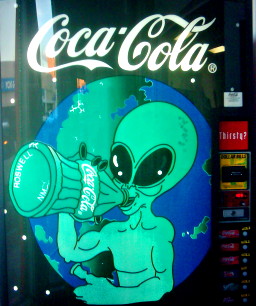 Yes, the one from the Futurama episode. Though they didn’t talk much about cows in that one.
Yes, the one from the Futurama episode. Though they didn’t talk much about cows in that one.
Besides, for some reason I get the impression that milk isn’t necessarily the most popular beverage here. Indeed, I get the impression that the dairy products around here are more industrial in nature. Heck, if you ask Google Maps for “cheese in Roswell, NM”, all that comes up is mass-market manufacturer “Leprino Foods”. What, not even any stores selling “moon cheese” to cash in on the whole UFO/Space-alien thing? Perhaps they only keep the cattle around to give the space-aliens something to practice their probing on.
With no prospects for sampling the apparently nonexistent famous regional cheeses, there was only one thing left to do. Yes, I admit it, we went to the UFO Museum (“and Research Center”).
I feel compelled to give them high praise on at least one point: they have signs which declare cameras and other recording gear to be explicitly permitted. A refreshing change after visiting the otherwise impressive Museum of Wildlife Art a few weeks back in Jackson, WY, which loudly forbade “cameras and cellphones”. Because, heaven forbid a blurry image taken by a cellphone of a painting which escaped copyright several centuries ago be seen on the internet without paying an additional fee. This would certainly cause the museum to collapse in bankruptcy within days.
But I digress…
Built into what appears to have once been an old single-screen movie theater building, it was well worth some touristy amusement. Ironically, I didn’t see a whole lot that I actually wanted to take pictures of. I did derive a certain amount of amusement from taking a picture of the framed photograph they had of a sign from Area 51 saying “no photography in this area”…but, appropriately enough, it came out too blurry to be verifiable. I suspect interference to my digital camera due CIA mind-control rays reflected from my Aluminum Foil Deflector Beanie.
It was actually kind of like a text-heavy art museum. Virtually all of the displays were framed photographs or copies of documents, though they do have, for example, what is apparently an authentic 1950’s USAF falling-from-great-heights test dummy on loan from somewhere. They still have lots of open space left, which is probably why they went ahead and filled one section with someone’s exhaustive and yet still laughable display on “crop circles”. Oddly enough, the portions dedicated to the actual “Roswell incident” aren’t bad. As you can imagine, I thought the presentation was still a bit overly credulous, but it was nowhere near what I had expected, which was a “balanced” presentation as favored by our mainstream media – that is, something along the lines of “could it be a crashed alien spaceship covered up by a secret government conspiracy, or merely this ridiculous story about a weather balloon?”. Instead, it looks like they’ve just collected as much as they could in the way of newspaper clippings, photographs, affidavits, reports, hypotheses (including, yes, the whacky ones) and so forth, and tried to present them all.
There was one really spooky thing I saw in there though:
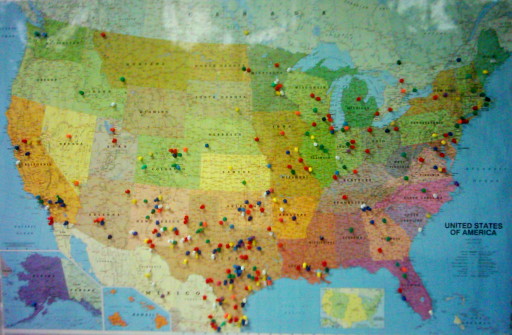
This map near the entrance is for visitors to mark where they’ve come from. I immediately noticed the odd clustering that seems to run from New Mexico, curving up through Texas, and up to Illinois. I mentioned this to my Minister of Domestic Affairs, who happens to be a geophysicist with a Ph.D. “Tornado Alley“, she immediately recognized and pointed out to me.
You all see, dear readers, where I’m going with this, don’t you? It’s so obvious:
- Tornadoes love trailer parks, right?
- What’s the stereotype of the kind of person who sees UFO’s or is abducted by aliens? The kind of people who are assumed to live in trailer parks, right?
- All those blurry photos of UFO’s come from devices for recording visual images, like, say, camcorders. Right?
- And, finally, it is a scientifically documented fact[1] that the occurence of tornadoes can be correlated to the combination of camcorder sales and trailer park presence.
THEREFORE
- This proves space-aliens cause tornadoes, perhaps to flush potential abductees out of hiding.
I eagerly await further research on my groundbreaking hypothesis.
Meanwhile, what’s a museum without a gift-shop, where fine and tasteful products may be purchased?
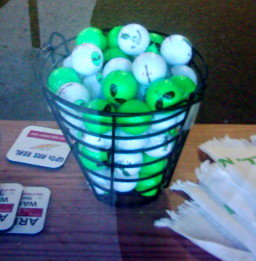
Uh…or maybe not.
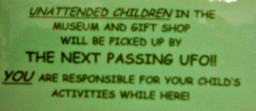
On a final note, I must say I approve of their unattended-child policy, though I have to admit I like the “free puppy and an espresso” one better.
[1] Wu F:”TORNADOES AND TRAILER PARKS: A STATISTICAL CORRELATION” Ann. Imp. Res.; Jul/Aug 1995 (1:4); pp 26-27 (also available online here).
 It’s slow going trying to get the mess up here in Idaho organized in preparation for the move to Texas, but I did manage to sacrifice a large number of my old books that I no longer need. Trading them in at the local representative of the “Hastings” bookstore chain got me a decent amount of store credit, and I was able to special-order this wine microbiology book I’ve been lusting after for months. It showed up a couple of days ago.
It’s slow going trying to get the mess up here in Idaho organized in preparation for the move to Texas, but I did manage to sacrifice a large number of my old books that I no longer need. Trading them in at the local representative of the “Hastings” bookstore chain got me a decent amount of store credit, and I was able to special-order this wine microbiology book I’ve been lusting after for months. It showed up a couple of days ago. Prior to that, I picked up a book I found at the local brewing-supply place in The Woodlands, Texas. It’s an entire book on the subject of Belgian and “Belgian-style” beers (like Lambic) fermented with “wild” yeasts and bacteria. It’s an excellent mix of history, science, travelogue, and “how-to”. I highly recommend it.
Prior to that, I picked up a book I found at the local brewing-supply place in The Woodlands, Texas. It’s an entire book on the subject of Belgian and “Belgian-style” beers (like Lambic) fermented with “wild” yeasts and bacteria. It’s an excellent mix of history, science, travelogue, and “how-to”. I highly recommend it. “Someone” seems to have located a replacement original disk of a game I had many years ago (but lost when I loaned it to
“Someone” seems to have located a replacement original disk of a game I had many years ago (but lost when I loaned it to  Yes, the one from the Futurama episode. Though they didn’t talk much about cows in that one.
Yes, the one from the Futurama episode. Though they didn’t talk much about cows in that one.


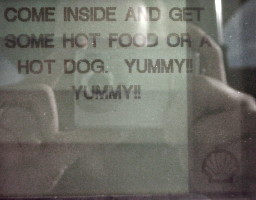 Meanwhile, I’ve thought about my “geotagging arbitrary files” issue a bit more. At this point I’m favoring the “geostrings” approach, split into what I’m calling “Where, When, and Whither” fields, which is to say, a field containing location (latitude, longitude, elevation), a field containing time-related information (timestamp, track-id), and a field containing direction (heading and angle) information. I’ve actually started putting geostrings in this form into some of the pictures I’ve been taking, just to get a feel for how easy or hard they are to work with. An example containing all information including the optinal stuff would look like this:
Meanwhile, I’ve thought about my “geotagging arbitrary files” issue a bit more. At this point I’m favoring the “geostrings” approach, split into what I’m calling “Where, When, and Whither” fields, which is to say, a field containing location (latitude, longitude, elevation), a field containing time-related information (timestamp, track-id), and a field containing direction (heading and angle) information. I’ve actually started putting geostrings in this form into some of the pictures I’ve been taking, just to get a feel for how easy or hard they are to work with. An example containing all information including the optinal stuff would look like this: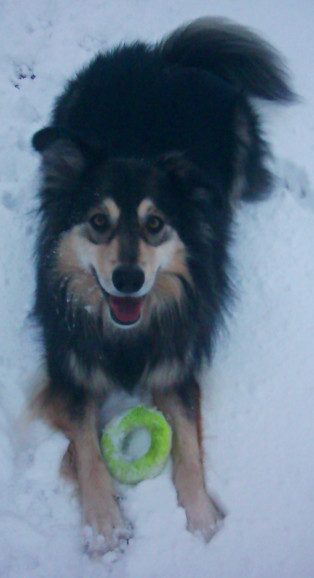 For no particular reason, here is a picture of The Dog in her natural habitat. This picture really has nothing to do with today’s blog post, but since this is supposed to be a happy time of year, I suppose a happy picture is in order.
For no particular reason, here is a picture of The Dog in her natural habitat. This picture really has nothing to do with today’s blog post, but since this is supposed to be a happy time of year, I suppose a happy picture is in order.